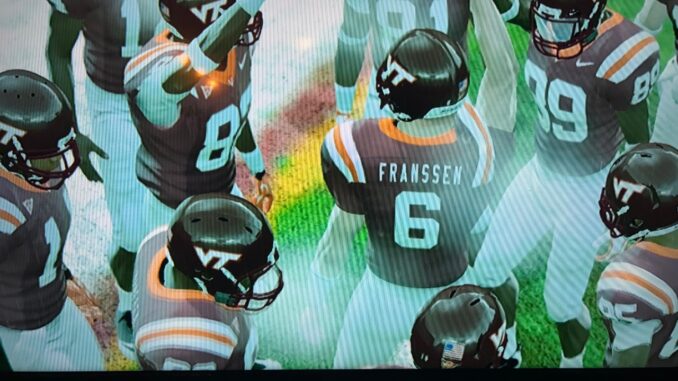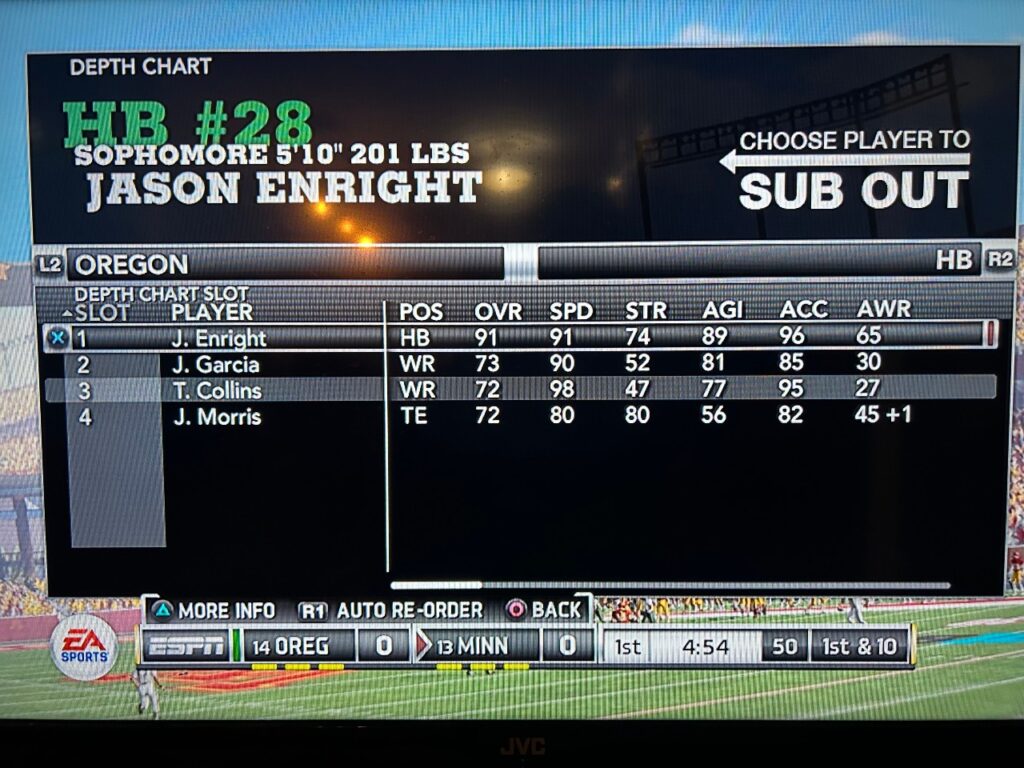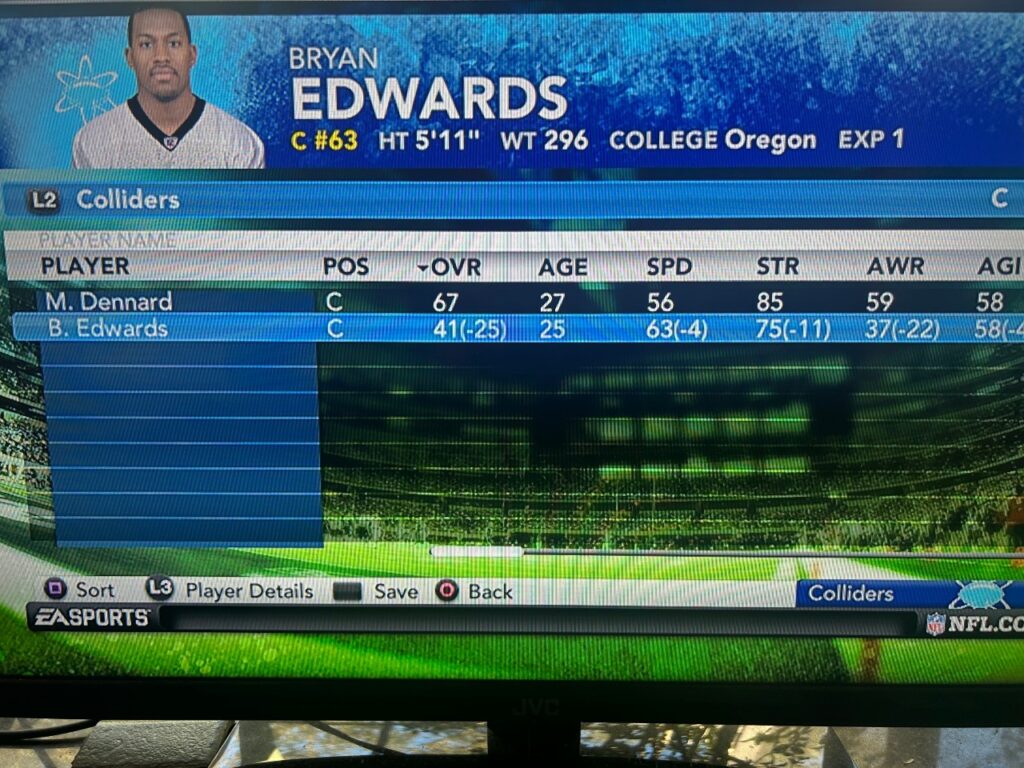
Minnesota’s overall ratings were down, but that was because they had to start lots of true freshman. Fortunately, many of Coach Kelly Krebs’s guys came through. Four-star ATHLETE recruits Lamar Whitehead and Cody Johnson stepped into starting roles at quarterback and running back, respectively.
In the professional ranks, the Batavia Colliders saw mass regression in what seems to be an utterly broken progression system, but put an insane defense on the field nevertheless. Read on for more details about the 2014 season!
Minnesota Golden Gophers
After playing a few seasons in both NCAA 12 and Madden 12, I have to say I prefer the college game. The presentation is better and it’s more difficult. Wins feel earned and I’ve had several games where the outcome was in doubt. Madden is cool in that I get to see the Colliders play against all of the fantasy teams I created, but I might have to up the difficulty on it, which I’m loathe to do because Madden interprets that as “just make all the linebackers jump 100 feet in the air to intercept every pass.”
The Golden Gophers scheduled Alabama, Virginia Tech, and Oregon in the first three weeks of the season in order to see the likes of Josh Hammond, Adam Franssen, Jason Enright, and Jesse Garcia in action. True Freshman QB Lamar Whitehead got the start in week one for the Gophers. His overall rating was lower than that of junior Kris Brink, but Brink only had 82 throw power. We didn’t need a repeat of the Kerry Harmon experience, so we went with the lower-rated freshman due to his 89 throw power.
Whitehead opened with a 4-TD torching of the Alabama Crimson Tide, leading the Gophers to a 48-29 victory. He tossed three touchdown bombs to WR Ryan Hill, including an 87 yarder. Ryan Hill was one of the three pass-catching Hill brothers, along with Adam Hill and Mike Hill, with Mike being the white guy so he’s the brother from another mother. Ryan looked like he might be on the verge of a Jacob Brooks type season until he got injured for most of the year. Quarterback Lamar Whitehead struggled a bit more with Ryan out of the lineup. But I digress.
WR Josh Hammond did manage to score a long TD against the Gophers, but it wasn’t enough given how Whitehead was dealing. Alabama, who was ranked #2 at the time, suffered another loss to the Gophers. They really shouldn’t schedule them.
In Week 2 the Gophers traveled to Blacksburg to take on the #7 rated Virginia Tech Hokies. 99-rated QB Adam Franssen could not match the Gopher offense, and Minnesota won 37-15 and subsequently jumped to #17 in the rankings.
Fans were excited, then, to host the #14-ranked Oregon Ducks. The Ducks had promising sophomore running back Jason Enright, much to the chagrin of the Corvallis faithful, and now the number one ranked wide receiver recruit Jesse Garcia. While Garcia was buried behind more established starters at wide receiver, the Oregon coach found creative ways to get his new playmaker into the game. Most notably, the wideout served as the backup running back to Jason Enright:

During the game, Enright was annoyingly difficult to tackle, and Garcia did break open a couple of screen passes. However, the Gophers dominated, winning a laugher 55-7. It was reminiscent of their random 52-3 shellacking of a highly rated Wisconsin team the year before. The ball bounced their way all game long and they were able to capitalize on several turnovers.
Krebs scheduled a “breather” game against FAU after their difficult early season schedule, and the Gophers won 37-7. They were 4-0 when they took on the #1 ranked Wisconsin Badgers, the team they beat in the Big Ten title game in 2013. It was in this game that Whitehead truly missed his number one receiver. Once the Badgers focused on stopping the run and shutting down TE Adam Hill, the Gophers were pretty much cooked. They lost 27-20 and Whitehead showed a newfound propensity for tossing interceptions. Uh oh.
Whitehead and company rallied, however, to win their next three games, including a 35-21 victory over #6-ranked Ohio State. Then they traveled to Iowa and pulled out a come-from-behind 27-21 victory. The next game was against Penn State, the team they had to engineer a miraculous comeback to defeat in 2013. Penn State played them tough again, running up a 20-7 lead that lasted into the fourth quarter. HB Cody Johnson found some running lanes (finally) and they were able to score to cut to the lead to 20-14 with about two minutes left. They needed a stop, and with about a minute left CB Sidney Moses lived up to his 5-star hype by securing a crucial interception. Whitehead drove down the shortened field and tossed a touchdown pass to TE Adam Hill to secure a 21-20 victory.
Meanwhile, Wisconsin remained number one for a while until they lost to Purdue. The Gophers ended up facing the Boilermakers, who were then ranked #5, in the Big Ten Championship game, where they easily won 30-6 in a cold Lucas Oil Stadium. That victory catapulted them to the #2 ranking and a date with undefeated Oklahoma in the BCS title game.
Coach Kelly Krebs found himself in the title game for the second year in a row, and despite a clearly established pattern of success, Minnesota’s “program stability” grade fell to D+. Make it make sense. Instead of bringing a seasoned-but-erratic senior QB into the game, Krebs had an unseasoned-sometimes-erratic freshman. But Whitehead wasn’t the only freshman. They were also starting freshmen at running back, (Cody Johnson), defensive end (Chuck Fellows), strong safety (Chris Parks), nickel corner (Greg Washington), punter (Sean Jones), and kicker (Ben Pershey). Would this group of youngsters overcome the undefeated Oklahoma Sooners and Heisman-winning quarterback Justin Walker?
It was a hard fought game, but two field goals from Ben Pershey, who converted 30/31 field goals on the season, were the difference as the Gophers won 27-19 for Coach Krebs’s first ever national championship. The fact that they won it with so many freshmen has led to a lot of excitement in Minneapolis. Could this be the beginning of a dynasty?
The Gophers’s success was not lost on the 2014 recruiting class. Krebs was able to pull in four 5-star recruits, including highly touted corner Rob Franssen, the younger brother of Virginia Tech’s QB Adam Franssen. They also brought in seven 4-star recruits and at the end of the day had the #2 rated recruiting class. The future in Minneapolis is bright.
But it wasn’t all sunshine and rainbows. 4-star recruit HB Seth Fisher decided to transfer to Michigan, just because Krebs promised him “solid playing time” in his first season and then redshirted him. To be fair, Fisher was a “4-star” recruit, but was only a 67-overall. Fuck Seth Fisher. Enjoy being buried on Michigan’s depth chart and losing to the Gophers every year.
Krebs signed a 3-year extension after winning the title. If Minnesota was smart they’d offer him a lifetime contract and a key to the city. NO. A key to both cities.
Batavia Colliders
We’re going to start with a bit of grumbling. So player progression seems to have nothing to do with on-field performance and is likely pre-determined by the player’s “potential” rating. My backup quarterbacks played well in relief of oft-injured Greg McLain, so naturally they both regressed. This has offered some clarity when it comes to scouting. It is literally pointless to draft any players who don’t have an A or B potential.
The scouting system is somewhat annoying in that it doesn’t give you an opportunity to scout the stats that matter most to the position you’re scouting. It’s pretty crazy that if you want to know how fast someone is you have to wait until the combine (meaning you can only learn the speed of 20 of the 250 draft picks). If you’re scouting corners you literally cannot know their Man Coverage or Zone Coverage ratings unless you make them one of the 5 “personal workout” players you get. All of this is to say that the “in-season” scouting, which happens five times during the course of the season, is largely useless. I’ve learned the best bet is to scout all the offensive linemen during that time.
I like Madden 13’s scouting and progression system much more. You have scouting points that you can spend on whatever stat you want, with things like player development being almost cost-prohibitive. The downside, of course, is that you can’t import draft classes or have created teams in that game, so I’ll stick with the ability to play with the Colliders I guess.
There’s also no training system or ways to improve guys naturally. So I can’t work on my backups in practice to make them good. I don’t think in-game performance matters much, but if a guy never plays he really regresses. Maybe like me you’re thinking, “well, I’ll use this late round draft pick for some depth. I’ll take a center from an established and successful college program”:

Oh, did you regress 25 fucking points after your rookie season on the bench? Bro lost 11 points in strength and got dumber by a considerable margin. The only explanation is that he got a severe case of long COVID.
The Colliders were an 84-overall team for the second year in a row due to regression. Most of the league is around 87 now. But that’s because I have some rules for myself.
First, I don’t sign free agents unless I need to for injury purposes. I prefer to all of my team building through the draft. Secondly, I don’t trade for draft picks except to go and get a college recruit I made. So next season I’ll likely have to trade up to get either Adam Franssen or Josh Hammond. Also, those guys better be A-potentials when they declare for the draft.
However, one fun thing is that I got an absolute steal in the 5th round of my first draft, nabbing DT Brenden Ulm, the one bright spot who has progressed to a 95-overall in three seasons (the number one DT in the league.) I still contend that DTs are overpowered in this version of NCAA/Madden, but I didn’t complain about his 19 sacks in 2014. He’s a big part of the reason the Colliders gave up a grand total of 73 points during a 16-0 regular season campaign.
Ridiculous.
It wasn’t all about defense, though. The Colliders finally got to play with A-potential, first round running back Perry Higgins out of South Carolina after seeing him sit on Injured Reserve for his rookie campaign. Batavia would finally move on from the plodding-but-productive running back Jyhe Holliday. But just three carries into the first game, Higgins got hurt. He’d miss the rest of week 1 and the next three weeks after.
When he did come back, though, he was electric. There was a noticeable difference between a running back with 95 speed versus 85 speed. When Higgins found a lane he could break off huge runs in ways that Holliday never could. He was named the NFL MVP despite playing 75% of the season.
Wide receiver Tramell Diggs was once again named the WR of the year. The Colliders are still looking for a reliable #2 target. They tried replacing TE Chandler Palmer with Sam Hughes, a TE out of Iowa with 90-speed. His excessive speed never seemed to materialize, and he got hurt at the end of the season, so he regressed in the offseason, naturally (including losing some of that 90-speed.)
Greg McLain missed a bunch of time again in 2014, living up to his “Injury Prone” role designation. He’s a 90-overall and so demanded a $60 million contract. The Colliders opted to franchise tag him and go after QB Adam Franssen in the next draft.
The Colliders cut their 95-rated kicker Benton Cannon due to his weak leg and picked up free agent rookie kicker Bo Houston, who is only a 78-overall but has 98 kick power, which is all I need. Houston was instantly better, converting all of his field goals.
One of the other rules I have for myself is that I don’t play the playoffs so that I don’t rack up 10 Super Bowls in a row. Regardless, the Colliders have won 3 of the 4 Super Bowls so far, including capping a perfect 19-0 season in 2014. I’m not sure why they are dominating in simulations since they are rated lower than most teams. I guess head coach Amari Jenkins has the special magic that gets his guys to perform at a high level.
It’s gotta be tough to play in the Colliders’ division. The Cleveland Battery were 9-0 when they matched up with Batavia, only to lose twice to them down the stretch. They finished 13-3 and still managed to land 3 games back. Another surprise was the Sullivan’s Island Silvertips going 15-1. Still not the best record in a league that contains a juggernaut like the Colliders.
So where do the Colliders go from here? They really seem to just be biding their time until Minnesota is talented enough to produce draft prospects that might make scouting somewhat interesting. I’ll admit it was fun to play with a talented running back. Let’s add some good QB play and then we’ll be talking.
On to 2015!
© 2025, Josh Hammond. All rights reserved.


Leave a Reply
You must be logged in to post a comment.